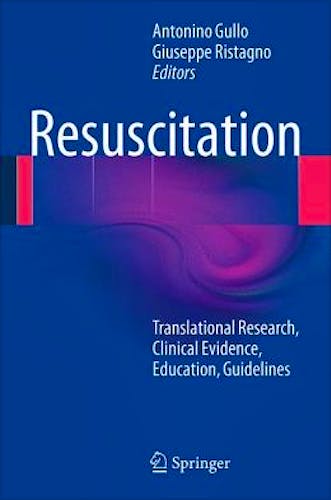

No hay productos en el carrito



Resuscitation. Translational Research, Clinical Evidence, Education, Guidelines
Gullo, A. — Ristagno, G.
1ª Edición Febrero 2014
Inglés
Tapa dura
254 pags
800 gr
null x null x null cm
ISBN 9788847055063
Editorial SPRINGER
LIBRO IMPRESO
-5%
103,99 €98,79 €IVA incluido
99,99 €94,99 €IVA no incluido
Recíbelo en un plazo de
2 - 3 semanas
Description
· Up- to- date evidence from the most recent experimental and clinical
trials on resuscitation science
· Hot and controversial topics on resuscitation discussed by top experts
in the field
· Gold standard resuscitation and post- resuscitation treatments and
interventions?
Resuscitation is a two-stage process comprising the achievement/maintenance
of spontaneous circulation and post-resuscitation management. The approach is
complex and multifaceted and entails the integration of new physiological insights,
pharmacological options, and technological advances. The purpose of this volume,
written by top experts in the field, is to promote, share, and disseminate new
advances in resuscitation and post-resuscitation care. The issues addressed
are wide ranging and of great topical interest or controversy. They include
priorities of intervention, quality of resuscitation, use of mechanical supports,
new defibrillation strategies, prevention of organ damage, strategies in cases
of sudden cardiac death, new pharmacological treatments, and post-resuscitation
care, including temperature management and prediction and improvement of outcome
after cardiac arrest. Particular attention is devoted to up-to-date evidence
from the most recent experimental and clinical trials on resuscitation science
and to gold standard evidence-based resuscitation and post-resuscitation treatments
and interventions. In addition, organizational models and integrated care systems
for trauma are considered, and critical care education and the process of guideline
development are reviewed.
Table of contents
Preface.- I State of the Art in Resuscitation.- 1 Resuscitation science: from the beginning to the present day.- 2 From Experimental and Clinical Evidence to Guidelines.- 3 Trauma Systems and Trauma Care.- II Advances on Cardiopulmonary Resuscitation (CPR) and Defibrillation.- 4 Compression only CPR versus CPR with ventilations.- 5 Defibrillation and Resuscitation.- 6 Amplitude Spectrum Area to predict the success of defibrillation and to guide resuscitation interventions.- 7 The importance of automated external defibrillation implementation programs.- III Optimization of Cardiopulmonary and Cerebral Resuscitation on Sudden Cardiac Death.- 8 Manual vs Mechanical Chest Compression.- 9 Optimized Approach in Cardiocerebral Resuscitation.- 10 Reperfusion Strategies in Sudden Cardiac Arrest.- 11 Extracorporeal Membrane Oxygenation (ECMO) Strategy in Cardiac Arrest.- IV Pharmacological Approach during CPR.- 12 Vasopressors during CPR.- 13 Targeting Mitochondria during CPR.- 14 The Potential Contribution of Corticosteroids to Positive Cardiac Arrest Outcomes.- 15 Pharmacological induction of hypothermia.- V Post Resuscitation Care.- 16 Effectiveness of Hypothermia in Human Cardiac Arrest and Update on the Target Temperature Management Trial.- 17 New Strategies to Improve Outcome After Cardiac Arrest.- 18 New methods to induce localized brain and general hypothermia.- 19 Predicting Outcome of Cardiac Arrest.- VI Combining Physiology, Clinical Outcome, and Ethics.- 20 Circulating Cardiac Biomarkers and Outcome.- 21 Circulatory Shock: Definition, Assessment and Management.- 22 Resuscitation and Ethics.
© 2025 Axón Librería S.L.
2.149.0